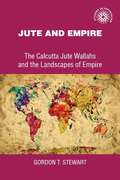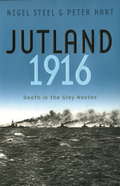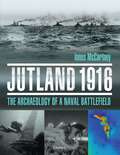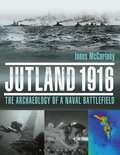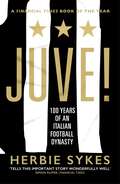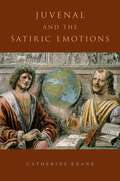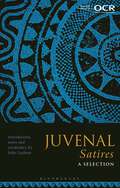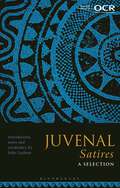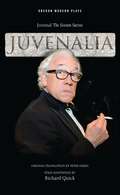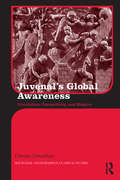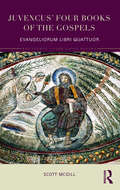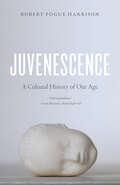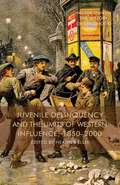- Table View
- List View
Jute and empire (Studies in Imperialism)
by Gordon StewartDundee had an interesting role to play in the jute trade, but the main player in the story of jute was Calcutta. This book follows the relationship of jute to empire, and discusses the rivalry between the Scottish and Indian cities from the 1840s to the 1950s and reveals the architecture of jute's place in the British Empire. The book adopts significant fresh approaches to imperial history, and explores the economic and cultural landscapes of the British Empire. Jute had been grown, spun and woven in Bengal for centuries before it made its appearance as a factory-manufactured product in world markets in the late 1830s. The book discusses the profits made in Calcutta during the rise of jute between the 1880s and 1920s; the profits reached extraordinary levels during and after World War I. The Calcutta jute industry entered a crisis period even before it was pummelled by the depression of the 1930s. The looming crisis stemmed from the potential of the Calcutta mills to outproduce world demand many times over. The St Andrew's Day rituals in Calcutta, begun three years before the founding of the Indian Jute Mills Association. The ceremonial occasion helps the reader to understand what the jute wallahs meant when they said they were in Calcutta for 'the greater glory of Scotland'. The book sheds some light on the contentious issues surrounding the problematic, if ever-intriguing, phenomenon of British Empire. The jute wallahs were inextricably bound up in the cultural self-images generated by British imperial ideology.
Jutland, 1916: Death in the Grey Wastes (Sven Hassel War Classics)
by Peter Hart Nigel SteelDramatic, illustrated account of the biggest naval battle of the First World War.On 31 May, 1916, the great battle fleets of Britain and Germany met off Jutland in the North Sea. It was a climactic encounter, the culmination of a fantastically expensive naval race between the two countries, and expectations on both sides were high. For the Royal Navy's Grand Fleet, there was the chance to win another Trafalgar. For the German High Seas Fleet, there was the opportunity to break the British blockade and so change the course of the war. But Jutland was a confused and controversial encounter. Tactically, it was a draw; strategically, it was a British victory.Naval historians have pored over the minutiae of Jutland ever since. Yet they have largely ignored what the battle was actually like for its thousands of participants. Full of drama and pathos, of chaos and courage, JUTLAND, 1916 describes the sea battle in the dreadnought era from the point of view of those who were there.
Jutland 1916: The Archaeology of a Naval Battlefield
by Innes McCartneyThe Battle of Jutland was the largest naval battle and the only full-scale clash of battleships in the First World War. For years the myriad factors contributing to the loss of many of the ships remained a mystery, subject only to speculation and theory. In this book, marine archaeologist and historian Dr Innes McCartney reveals for the first time what became of the warships that vanished on the night of 31st May 1916, examining the circumstances behind the loss of each ship and reconciling what was known in 1916 to what the archaeology is revealing today. The knowledge of what was present was transformed in 2015 by a groundbreaking survey using the modern technology of multi-beam. This greatly assisted in unravelling the details behind several Jutland enigmas, not least the devastating explosions which claimed five major British warships, the details of the wrecks of the 13 destroyers lost in the battle and the German warships scuttled during the night phase. This is the first book to identify the locations of many of the wrecks, and – scandalously – how more than half of these sites have been illegally plundered for salvage, despite their status as war graves. An essential and revelatory read for anyone interested in naval history and marine archaeology.
Jutland 1916: The Archaeology of a Naval Battlefield
by Innes McCartneyThe Battle of Jutland was the largest naval battle and the only full-scale clash of battleships in the First World War. For years the myriad factors contributing to the loss of many of the ships remained a mystery, subject only to speculation and theory. In this book, marine archaeologist and historian Dr Innes McCartney reveals for the first time what became of the warships that vanished on the night of 31st May 1916, examining the circumstances behind the loss of each ship and reconciling what was known in 1916 to what the archaeology is revealing today. The knowledge of what was present was transformed in 2015 by a groundbreaking survey using the modern technology of multi-beam. This greatly assisted in unravelling the details behind several Jutland enigmas, not least the devastating explosions which claimed five major British warships, the details of the wrecks of the 13 destroyers lost in the battle and the German warships scuttled during the night phase. This is the first book to identify the locations of many of the wrecks, and – scandalously – how more than half of these sites have been illegally plundered for salvage, despite their status as war graves. An essential and revelatory read for anyone interested in naval history and marine archaeology.
Jutland 1916: The Archaeology of a Naval Battlefield
by Innes McCartneyThe Battle of Jutland was the largest naval battle and the only full-scale clash of battleships in the First World War. For years the myriad factors contributing to the loss of many of the ships remained a mystery, subject only to speculation and theory. In this book, marine archaeologist and historian Dr Innes McCartney reveals for the first time what became of the warships that vanished on the night of 31st May 1916, examining the circumstances behind the loss of each ship and reconciling what was known in 1916 to what the archaeology is revealing today. The knowledge of what was present was transformed in 2015 by a groundbreaking survey using the modern technology of multi-beam. This greatly assisted in unravelling the details behind several Jutland enigmas, not least the devastating explosions which claimed five major British warships, the details of the wrecks of the 13 destroyers lost in the battle and the German warships scuttled during the night phase. This is the first book to identify the locations of many of the wrecks, and – scandalously – how more than half of these sites have been illegally plundered for salvage, despite their status as war graves. An essential and revelatory read for anyone interested in naval history and marine archaeology.
Juve!: 100 Years of an Italian Football Dynasty
by Herbie SykesThe definitive history of the iconic football club: the glory, the scandal, the stars and its enduring influence on Italian life.Juventus utterly dominates the Italian game. Home to some of the biggest names in sport, it has won title after title, trophy after trophy. However, parallel to the success and myth, there’s a murkier reality. For one hundred years the club and its billionaire owners, the Agnelli family, have been synonymous with match-fixing, doping, political chicanery and more. While La Vecchia Signora remains Italy’s best-supported team, it’s also its most despised.Juve! charts the story of Italy’s great sporting dynasty, chronicling the triumphs and tragedies of the Agnellis, and of the icons – Boniperti, Del Piero, Ronaldo – who have been their sporting emissaries for almost a century. The pride of Italy or its dark heart? Footballing colossus or vanity project? With this unique institution, as with so much about life in Italy, things are seldom black and white…
Juvenal and the Satiric Emotions
by Catherine KeaneIn his sixteen verse Satires, Juvenal explores the emotional provocations and pleasures associated with social criticism and mockery. He makes use of traditional generic elements such as the first-person speaker, moral diatribe, narrative, and literary allusion to create this new satiric preoccupation and theme. Juvenal defines the satirist figure as an emotional agent who dramatizes his own response to human vices and faults, and he in turn aims to engage other people's feelings. Over the course of his career, he adopts a series of rhetorical personae that represent a spectrum of satiric emotions, encouraging his audience to ponder satire's proper emotional mode and function. Juvenal first offers his signature indignatio with its associated pleasures and discomforts, then tries on subtler personae that suggest dry detachment, callous amusement, anxiety, and other affective states. As Keane shows, the satiric emotions are not only found in the author's rhetorical performances, but they are also a major part of the human farrago that the Satires purport to treat. Juvenal's poems explore the dynamic operation of emotions in society, drawing on diverse ancient literary, rhetorical, and philosophical sources. Each poem uniquely engages with different texts and ideas to reveal the unsettling powers of its emotional mode. Keane also analyzes the "emotional plot" of each book of Satires and the structural logic of the entire series with its wide range of subjects and settings. From his famous angry tirades to his more puzzling later meditations, Juvenal demonstrates an enduring interest in the relationship between feelings and moral judgment.
Juvenal and the Satiric Emotions
by Catherine KeaneIn his sixteen verse Satires, Juvenal explores the emotional provocations and pleasures associated with social criticism and mockery. He makes use of traditional generic elements such as the first-person speaker, moral diatribe, narrative, and literary allusion to create this new satiric preoccupation and theme. Juvenal defines the satirist figure as an emotional agent who dramatizes his own response to human vices and faults, and he in turn aims to engage other people's feelings. Over the course of his career, he adopts a series of rhetorical personae that represent a spectrum of satiric emotions, encouraging his audience to ponder satire's proper emotional mode and function. Juvenal first offers his signature indignatio with its associated pleasures and discomforts, then tries on subtler personae that suggest dry detachment, callous amusement, anxiety, and other affective states. As Keane shows, the satiric emotions are not only found in the author's rhetorical performances, but they are also a major part of the human farrago that the Satires purport to treat. Juvenal's poems explore the dynamic operation of emotions in society, drawing on diverse ancient literary, rhetorical, and philosophical sources. Each poem uniquely engages with different texts and ideas to reveal the unsettling powers of its emotional mode. Keane also analyzes the "emotional plot" of each book of Satires and the structural logic of the entire series with its wide range of subjects and settings. From his famous angry tirades to his more puzzling later meditations, Juvenal demonstrates an enduring interest in the relationship between feelings and moral judgment.
Juvenal Satires: A Selection
by John GodwinThis is the OCR-endorsed edition covering the Latin AS and A-Level (Group 3) prescription of Juvenal, Satire 6 and the A-Level (Group 4) prescription of Satires 14 and 15, giving full Latin text, commentary and vocabulary, with a detailed introduction that also covers the prescribed material to be read in English for A Level. Juvenal was the last and the greatest of the Roman verse satirists and his poetry gives us an exuberant and outrageously jaundiced view of the early Roman Empire. This book contains a selection from three of his satires: Satire 6 attacks women and marriage, Satire 14 critiques the role played by parents in the education of children and Satire 15 describes all too vividly the cannibalism perpetrated by warring Egyptians. These Satires expose the folly and the wickedness of the world in some of the finest Latin to have survived from antiquity.Supporting resources are available on the Companion Website: https://www.bloomsbury.pub/OCR-editions-2024-2026
Juvenal Satires: A Selection
This is the OCR-endorsed edition covering the Latin AS and A-Level (Group 3) prescription of Juvenal, Satire 6 and the A-Level (Group 4) prescription of Satires 14 and 15, giving full Latin text, commentary and vocabulary, with a detailed introduction that also covers the prescribed material to be read in English for A Level. Juvenal was the last and the greatest of the Roman verse satirists and his poetry gives us an exuberant and outrageously jaundiced view of the early Roman Empire. This book contains a selection from three of his satires: Satire 6 attacks women and marriage, Satire 14 critiques the role played by parents in the education of children and Satire 15 describes all too vividly the cannibalism perpetrated by warring Egyptians. These Satires expose the folly and the wickedness of the world in some of the finest Latin to have survived from antiquity.Supporting resources are available on the Companion Website: https://www.bloomsbury.pub/OCR-editions-2024-2026
Juvenalia (Oberon Modern Plays)
by Richard QuickSimon Callow does stand-up comedy. Filthy, foul mouthed, viciously funny and deeply politically incorrect. The target: immigrants, plutocrats, women, gays. As last delivered in Rome AD 100. Juvenal was one angry white middle-class male. In Juvenalia he tells it like it was. And is. The writer, Juvenal born circa AD55, wrote sixteen satires that attacked the decadence of Rome in its heyday. Here, adapted by Richard Quick, we are given a view into the moral decline that is as relevant now, as it was back then.
Juvenal's Global Awareness: Circulation, Connectivity, and Empire (Routledge Monographs in Classical Studies)
by Osman UmurhanIn Juvenal’s Global Awareness Osman Umurhan applies theories of globalization to an investigation of Juvenal’s articulation and understanding of empire, imperialism and identity. Umurhan explains how the increased interconnectivity between different localities, ethnic and political, shapes Juvenal’s view of Rome as in constant flux and motion. Theoretical and sociological notions of deterritorialization, time-space compression and the rhizome inform the satirist’s language of mobility and his construction of space and place within second century Rome and its empire. The circulation of people, goods and ideas generated by processes of globalization facilitates Juvenal’s negotiation of threats and changes to Roman institutions that include a wide array of topics, from representatios of the army and food to discussions of cannibalism and language. Umurhan’s analysis stresses that Juvenalian satire itself is a rhizome in both function and form. This study is designed for audiences interested in Juvenal, empire and globalization under Rome.
Juvenal's Global Awareness: Circulation, Connectivity, and Empire (Routledge Monographs in Classical Studies)
by Osman UmurhanIn Juvenal’s Global Awareness Osman Umurhan applies theories of globalization to an investigation of Juvenal’s articulation and understanding of empire, imperialism and identity. Umurhan explains how the increased interconnectivity between different localities, ethnic and political, shapes Juvenal’s view of Rome as in constant flux and motion. Theoretical and sociological notions of deterritorialization, time-space compression and the rhizome inform the satirist’s language of mobility and his construction of space and place within second century Rome and its empire. The circulation of people, goods and ideas generated by processes of globalization facilitates Juvenal’s negotiation of threats and changes to Roman institutions that include a wide array of topics, from representatios of the army and food to discussions of cannibalism and language. Umurhan’s analysis stresses that Juvenalian satire itself is a rhizome in both function and form. This study is designed for audiences interested in Juvenal, empire and globalization under Rome.
Juvenal’s Tenth Satire
by Professor Paul MurgatroydThis is not a commentary on Juvenal Satire 10 but a critical appreciation of the poem which examines it on its own and in context and tries to make it come alive as a piece of literature, offering one man’s close reading of Satire 10 as poetry, and concerned with literary criticism rather than philological minutiae. In line with the recent broadening of insight into Juvenal’s writing this book often addresses the issues of distortion and problematizing and covers style, sound and diction as well. Much time is also devoted to intertextuality and to humour, wit and irony. Building on the work of scholars like Martyn, Jenkyns and Schmitz, who see in Juvenal a consistently skilful and sophisticated author, this is a whole book demonstrating a high level of expertise on Juvenal’s part sustained throughout; a long poem (rather than intermittent flashes). This investigation of 10 leads to the conclusion that Juvenal is an accomplished poet and provocative satirist, a writer with real focus, who makes every word count, and a final chapter exploring Satires 11 and 12 confirms that assessment. Translation of the Latin and explanation of references are included so that Classics students will find the book easier to use and it will also be accessible to scholars and students interested in satire outside of Classics departments.
Juvencus' Four Books of the Gospels: Evangeliorum Libri Quattuor (Routledge Later Latin Poetry)
by Scott McGillJuvencus’ Evangeliorum libri IV, or "The Four Books of the Gospels," is a verse rendering of the gospel narrative written ca. 330 CE. Consisting of around 3200 hexameter lines, it is the first of the Latin "Biblical epics" to appear in antiquity, and the first classicizing, hexameter poem on a Christian topic to appear in the western tradition. As such, it is an important text in literary and cultural history. This is the first English translation of the entire poem. The lack of a full English translation has kept many scholars and students, particularly those outside of Classics, and many educated general readers from discovering it. With a thorough introduction to aid in the interpretation and appreciation of the text this clear and accessible English translation will enable a clearer understanding of the importance of Juvencus’ work to later Latin poetry and to the early Church.
Juvencus' Four Books of the Gospels: Evangeliorum Libri Quattuor (Routledge Later Latin Poetry)
by Scott McGillJuvencus’ Evangeliorum libri IV, or "The Four Books of the Gospels," is a verse rendering of the gospel narrative written ca. 330 CE. Consisting of around 3200 hexameter lines, it is the first of the Latin "Biblical epics" to appear in antiquity, and the first classicizing, hexameter poem on a Christian topic to appear in the western tradition. As such, it is an important text in literary and cultural history. This is the first English translation of the entire poem. The lack of a full English translation has kept many scholars and students, particularly those outside of Classics, and many educated general readers from discovering it. With a thorough introduction to aid in the interpretation and appreciation of the text this clear and accessible English translation will enable a clearer understanding of the importance of Juvencus’ work to later Latin poetry and to the early Church.
Juvenescence: A Cultural History of Our Age
by Robert Pogue HarrisonHow old are you? The more thought you bring to bear on the question, the harder it is to answer. For we age simultaneously in different ways: biologically, psychologically, socially. And we age within the larger framework of a culture, in the midst of a history that predates us and will outlast us. Looked at through that lens, many aspects of late modernity would suggest that we are older than ever, but Robert Pogue Harrison argues that we are also getting startlingly younger—in looks, mentality, and behavior. We live, he says, in an age of juvenescence. Like all of Robert Pogue Harrison's books, Juvenescence ranges brilliantly across cultures and history, tracing the ways that the spirits of youth and age have inflected each other from antiquity to the present. Drawing on the scientific concept of neotony, or the retention of juvenile characteristics through adulthood, and extending it into the cultural realm, Harrison argues that youth is essential for culture’s innovative drive and flashes of genius. At the same time, however, youth—which Harrison sees as more protracted than ever—is a luxury that requires the stability and wisdom of our elders and the institutions. “While genius liberates the novelties of the future,” Harrison writes, “wisdom inherits the legacies of the past, renewing them in the process of handing them down.” A heady, deeply learned excursion, rich with ideas and insights, Juvenescence could only have been written by Robert Pogue Harrison. No reader who has wondered at our culture's obsession with youth should miss it.
Juvenescence: A Cultural History of Our Age
by Robert Pogue HarrisonHow old are you? The more thought you bring to bear on the question, the harder it is to answer. For we age simultaneously in different ways: biologically, psychologically, socially. And we age within the larger framework of a culture, in the midst of a history that predates us and will outlast us. Looked at through that lens, many aspects of late modernity would suggest that we are older than ever, but Robert Pogue Harrison argues that we are also getting startlingly younger—in looks, mentality, and behavior. We live, he says, in an age of juvenescence. Like all of Robert Pogue Harrison's books, Juvenescence ranges brilliantly across cultures and history, tracing the ways that the spirits of youth and age have inflected each other from antiquity to the present. Drawing on the scientific concept of neotony, or the retention of juvenile characteristics through adulthood, and extending it into the cultural realm, Harrison argues that youth is essential for culture’s innovative drive and flashes of genius. At the same time, however, youth—which Harrison sees as more protracted than ever—is a luxury that requires the stability and wisdom of our elders and the institutions. “While genius liberates the novelties of the future,” Harrison writes, “wisdom inherits the legacies of the past, renewing them in the process of handing them down.” A heady, deeply learned excursion, rich with ideas and insights, Juvenescence could only have been written by Robert Pogue Harrison. No reader who has wondered at our culture's obsession with youth should miss it.
Juvenescence: A Cultural History of Our Age
by Robert Pogue HarrisonHow old are you? The more thought you bring to bear on the question, the harder it is to answer. For we age simultaneously in different ways: biologically, psychologically, socially. And we age within the larger framework of a culture, in the midst of a history that predates us and will outlast us. Looked at through that lens, many aspects of late modernity would suggest that we are older than ever, but Robert Pogue Harrison argues that we are also getting startlingly younger—in looks, mentality, and behavior. We live, he says, in an age of juvenescence. Like all of Robert Pogue Harrison's books, Juvenescence ranges brilliantly across cultures and history, tracing the ways that the spirits of youth and age have inflected each other from antiquity to the present. Drawing on the scientific concept of neotony, or the retention of juvenile characteristics through adulthood, and extending it into the cultural realm, Harrison argues that youth is essential for culture’s innovative drive and flashes of genius. At the same time, however, youth—which Harrison sees as more protracted than ever—is a luxury that requires the stability and wisdom of our elders and the institutions. “While genius liberates the novelties of the future,” Harrison writes, “wisdom inherits the legacies of the past, renewing them in the process of handing them down.” A heady, deeply learned excursion, rich with ideas and insights, Juvenescence could only have been written by Robert Pogue Harrison. No reader who has wondered at our culture's obsession with youth should miss it.
Juvenescence: A Cultural History of Our Age
by Robert Pogue HarrisonHow old are you? The more thought you bring to bear on the question, the harder it is to answer. For we age simultaneously in different ways: biologically, psychologically, socially. And we age within the larger framework of a culture, in the midst of a history that predates us and will outlast us. Looked at through that lens, many aspects of late modernity would suggest that we are older than ever, but Robert Pogue Harrison argues that we are also getting startlingly younger—in looks, mentality, and behavior. We live, he says, in an age of juvenescence. Like all of Robert Pogue Harrison's books, Juvenescence ranges brilliantly across cultures and history, tracing the ways that the spirits of youth and age have inflected each other from antiquity to the present. Drawing on the scientific concept of neotony, or the retention of juvenile characteristics through adulthood, and extending it into the cultural realm, Harrison argues that youth is essential for culture’s innovative drive and flashes of genius. At the same time, however, youth—which Harrison sees as more protracted than ever—is a luxury that requires the stability and wisdom of our elders and the institutions. “While genius liberates the novelties of the future,” Harrison writes, “wisdom inherits the legacies of the past, renewing them in the process of handing them down.” A heady, deeply learned excursion, rich with ideas and insights, Juvenescence could only have been written by Robert Pogue Harrison. No reader who has wondered at our culture's obsession with youth should miss it.
Juvenescence: A Cultural History of Our Age
by Robert Pogue HarrisonHow old are you? The more thought you bring to bear on the question, the harder it is to answer. For we age simultaneously in different ways: biologically, psychologically, socially. And we age within the larger framework of a culture, in the midst of a history that predates us and will outlast us. Looked at through that lens, many aspects of late modernity would suggest that we are older than ever, but Robert Pogue Harrison argues that we are also getting startlingly younger—in looks, mentality, and behavior. We live, he says, in an age of juvenescence. Like all of Robert Pogue Harrison's books, Juvenescence ranges brilliantly across cultures and history, tracing the ways that the spirits of youth and age have inflected each other from antiquity to the present. Drawing on the scientific concept of neotony, or the retention of juvenile characteristics through adulthood, and extending it into the cultural realm, Harrison argues that youth is essential for culture’s innovative drive and flashes of genius. At the same time, however, youth—which Harrison sees as more protracted than ever—is a luxury that requires the stability and wisdom of our elders and the institutions. “While genius liberates the novelties of the future,” Harrison writes, “wisdom inherits the legacies of the past, renewing them in the process of handing them down.” A heady, deeply learned excursion, rich with ideas and insights, Juvenescence could only have been written by Robert Pogue Harrison. No reader who has wondered at our culture's obsession with youth should miss it.
Juvenescence: A Cultural History of Our Age
by Robert Pogue HarrisonHow old are you? The more thought you bring to bear on the question, the harder it is to answer. For we age simultaneously in different ways: biologically, psychologically, socially. And we age within the larger framework of a culture, in the midst of a history that predates us and will outlast us. Looked at through that lens, many aspects of late modernity would suggest that we are older than ever, but Robert Pogue Harrison argues that we are also getting startlingly younger—in looks, mentality, and behavior. We live, he says, in an age of juvenescence. Like all of Robert Pogue Harrison's books, Juvenescence ranges brilliantly across cultures and history, tracing the ways that the spirits of youth and age have inflected each other from antiquity to the present. Drawing on the scientific concept of neotony, or the retention of juvenile characteristics through adulthood, and extending it into the cultural realm, Harrison argues that youth is essential for culture’s innovative drive and flashes of genius. At the same time, however, youth—which Harrison sees as more protracted than ever—is a luxury that requires the stability and wisdom of our elders and the institutions. “While genius liberates the novelties of the future,” Harrison writes, “wisdom inherits the legacies of the past, renewing them in the process of handing them down.” A heady, deeply learned excursion, rich with ideas and insights, Juvenescence could only have been written by Robert Pogue Harrison. No reader who has wondered at our culture's obsession with youth should miss it.
Juvenile Crime and Dissent in Nazi Vienna, 1938-1945
by Evan Burr BukeyDrawing on a wealth of archival sources, Evan Burr Bukey's meticulous new study offers the definitive account of juvenile crime in Nazi-era Vienna. In analyzing the records of juvenile delinquency in Vienna during the Anschluss era, this book explores the impact the Juvenile Criminal Code had on the Viennese youth who were brought before the bench for deviant behavior.Juvenile Crime and Dissent in Nazi Vienna addresses one key question: to what extent did Nazi rule constitute a rupture in the Austrian juvenile justice system? Ultimately this book reveals how, despite National Socialist institutions pervading Austrian society between 1938 and 1945, the survival of the indigenous legal order preserved a sense of regional identity that helps to explain the success of the Second Austrian Republic following the collapse of the Third Reich.
Juvenile Crime and Dissent in Nazi Vienna, 1938-1945
by Evan Burr BukeyDrawing on a wealth of archival sources, Evan Burr Bukey's meticulous new study offers the definitive account of juvenile crime in Nazi-era Vienna. In analyzing the records of juvenile delinquency in Vienna during the Anschluss era, this book explores the impact the Juvenile Criminal Code had on the Viennese youth who were brought before the bench for deviant behavior.Juvenile Crime and Dissent in Nazi Vienna addresses one key question: to what extent did Nazi rule constitute a rupture in the Austrian juvenile justice system? Ultimately this book reveals how, despite National Socialist institutions pervading Austrian society between 1938 and 1945, the survival of the indigenous legal order preserved a sense of regional identity that helps to explain the success of the Second Austrian Republic following the collapse of the Third Reich.
Juvenile Delinquency and the Limits of Western Influence, 1850-2000 (Palgrave Studies in the History of Childhood)
by Heather EllisThis volume brings together a wide range of case studies from across the globe, written by some of the leading scholars in the field, to explore the complex ways in which historical understandings of childhood and juvenile delinquency have been constructed in a global context.
